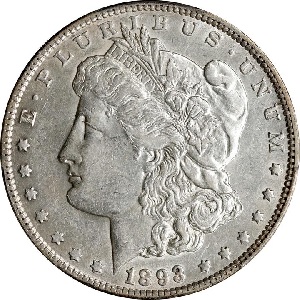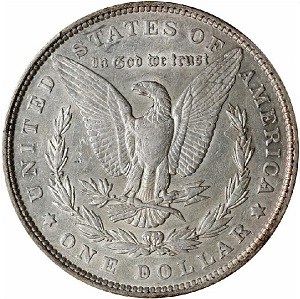1893 Morgan Dollar
By mid-1890, some 360 million Morgan silver dollars had been struck following the Bland-Allison Act of 1878, of which perhaps one-sixth were in circulation. With silver so abundant, its value plummeted dramatically. To address this anxiety, the Sherman Act was passed into law on July 14, 1890.(1)
The Act mandated the Treasury to purchase at market price 4.5 million ounces of silver monthly for minting additional dollars. The government was to pay for the bullion with Treasury notes redeemable in gold or silver coin.
Unexpectedly, the public favored note redemption in gold by a wide margin over silver, resulting in a rush on the nation’s gold reserves, pushing the United States to the brink of insolvency by early 1893.
The Panic of 1893 caused the loss of four million jobs and economic conditions that would not be felt again until the Great Depression of the 1930’s.(2)
Soon after taking office in March 1893, President Grover Cleveland successfully pushed for the repeal of the Sherman Act. Against this ominous financial backdrop, Morgan dollar production at all mint locations plunged sharply, down 77% from the previous year, and down 96% from 1890, the first year of the Sherman Act.
Some 378,000 Morgan dollars were struck in Philadelphia in 1893. This was the eighth lowest mintage for any Morgan business strike, which contributes mightily to its elusiveness today. Long-term percentage gains are impressive, although prices are down from their 2009 all-time highs, indicating NOW may be the time to add this rare Morgan dollar to your collection.
Please Note: For the Morgan dollar price trend survey, only grades F-12, VF-20, EF-40, AU-50, and MS-60 were analyzed. Higher grades, Prooflike (PL), and Deep Mirror Prooflike (DMPL) were omitted because in these conditions, even rather ordinary Morgan dates can attain astronomical values that could easily skew results. The goal of the survey is to identify coins demonstrating superior price trend histories, regardless of grade.
| Estimated survivors in all grades: 40027 ?
The survivor estimate from PCGS represents an average of one or more experts' opinions as to how many examples survive of a particular coin in all grades. Survival estimates include coins that are raw, certified by PCGS, and certified by other grading services. Learn more at PCGS. |
| PCGS Rarity Scale: 2.5 ?
The 'PCGS CoinFacts Rarity Scale' assesses the relative rarity of all U.S. coins, based on estimated surviving examples. The scale runs from 1.0 to 10.0. The higher the number, the rarer the coin.
Learn more at PCGS. |
| Click HERE to check for availability on eBay** |
Preview of eBay selection:
 |
 |
| Trendline Avg = 14.14 | GOOD |
Historic Value Trend Charts:
| Last updated 6-9-24 | Return to Key Date Coin List | |
| Compare to Common Date Coin of Same Type | ||
|
|
||
| Download Charts to Your Computer | ||
Sources
1. Taxay, Don. The U.S. Mint and Coinage. New York, NY: Sanford J. Durst Numismatic Publications, 1966.
2. Garrett, Jeff and Guth, Ron. 100 Greatest U.S. Coins, 5th ed. Pelham, AL: Whitman Publishing, 2019.
**Many very fine coin dealers sell on eBay. At any point in time, there may be over one million search results for United States coins. This includes quite a few of the recommendations on our Key Date Coin List.
If you’re thinking about purchasing a rare coin, eBay is certainly worth a look. For your convenience, the links from this site to eBay are coded to bring up only coins certified by PCGS and NGC.
As is always, always the case, never buy a valuable coin from a seller whose trustworthiness cannot be verified. Learn more about this at our chapter Best Places to Buy Coins, which also has a section on doing business on eBay.
In the interest of full disclosure, Rare Coins 101 receives a small commission anytime someone connects to eBay from this site and purchases something.
Coin images by Stack's Bowers Galleries.


